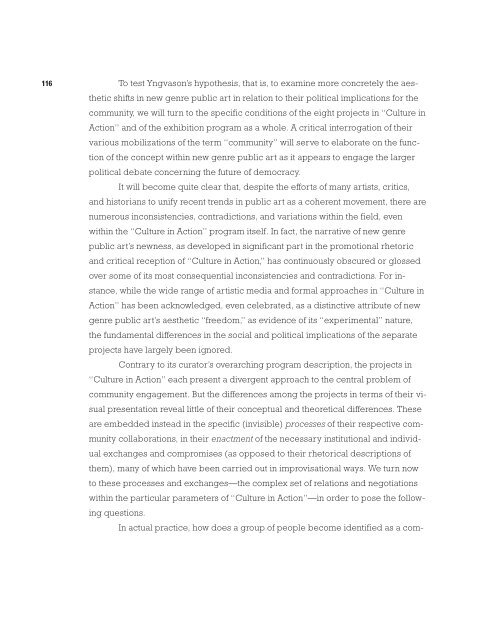ONE PLACE AFTER ANOTHER - Monoskop
ONE PLACE AFTER ANOTHER - Monoskop
ONE PLACE AFTER ANOTHER - Monoskop
Create successful ePaper yourself
Turn your PDF publications into a flip-book with our unique Google optimized e-Paper software.
116<br />
To test Yngvason’s hypothesis, that is, to examine more concretely the aes-<br />
thetic shifts in new genre public art in relation to their political implications for the<br />
community, we will turn to the specific conditions of the eight projects in “Culture in<br />
Action” and of the exhibition program as a whole. A critical interrogation of their<br />
various mobilizations of the term “community” will serve to elaborate on the function<br />
of the concept within new genre public art as it appears to engage the larger<br />
political debate concerning the future of democracy.<br />
It will become quite clear that, despite the efforts of many artists, critics,<br />
and historians to unify recent trends in public art as a coherent movement, there are<br />
numerous inconsistencies, contradictions, and variations within the field, even<br />
within the “Culture in Action” program itself. In fact, the narrative of new genre<br />
public art’s newness, as developed in significant part in the promotional rhetoric<br />
and critical reception of “Culture in Action,” has continuously obscured or glossed<br />
over some of its most consequential inconsistencies and contradictions. For instance,<br />
while the wide range of artistic media and formal approaches in “Culture in<br />
Action” has been acknowledged, even celebrated, as a distinctive attribute of new<br />
genre public art’s aesthetic “freedom,” as evidence of its “experimental” nature,<br />
the fundamental differences in the social and political implications of the separate<br />
projects have largely been ignored.<br />
Contrary to its curator’s overarching program description, the projects in<br />
“Culture in Action” each present a divergent approach to the central problem of<br />
community engagement. But the differences among the projects in terms of their visual<br />
presentation reveal little of their conceptual and theoretical differences. These<br />
are embedded instead in the specific (invisible) processes of their respective com-<br />
munity collaborations, in their enactment of the necessary institutional and individ-<br />
ual exchanges and compromises (as opposed to their rhetorical descriptions of<br />
them), many of which have been carried out in improvisational ways. We turn now<br />
to these processes and exchanges—the complex set of relations and negotiations<br />
within the particular parameters of “Culture in Action”—in order to pose the following<br />
questions.<br />
In actual practice, how does a group of people become identified as a com-

















